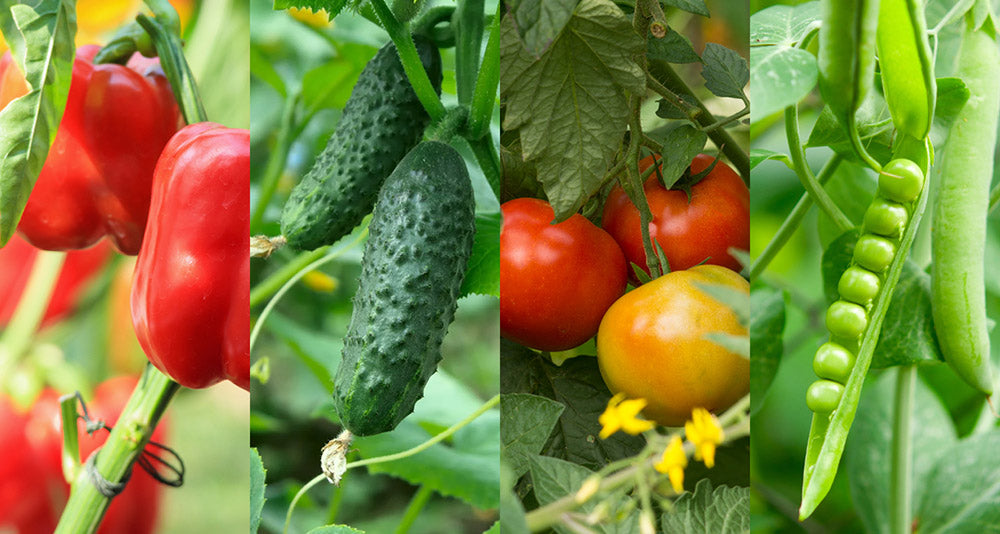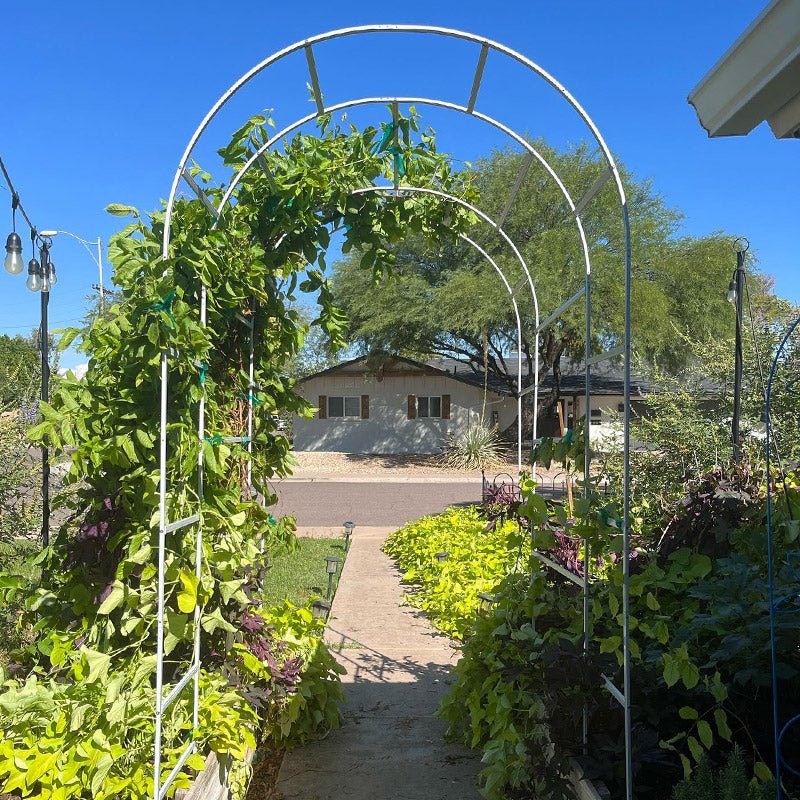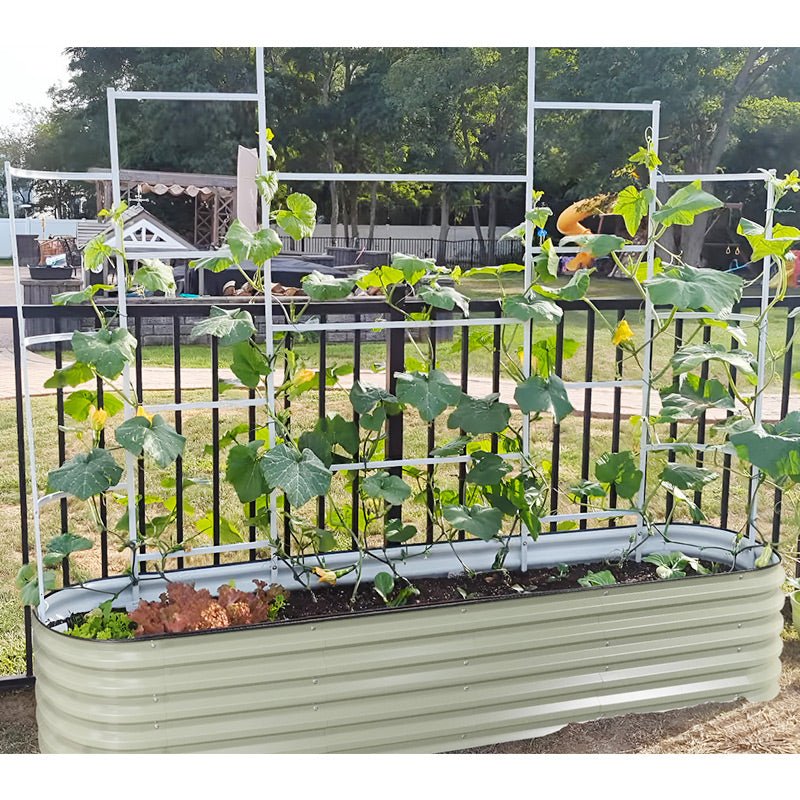The Best Climbing Plants For Garden Trellis
Kitchen gardening is enjoyable yet the most demanding activity. Why? All the routine garden practices, such as watering, feeding, pruning, and feeding, should be done per a strict schedule. If you are looking for the best vegetables to grow on a trellis, you must regularly remove the weak-stemmed plants during the growth period. For a vertical garden to grow, you need a sturdy garden trellis to support and guide the plants’ growth. In this blog, we will discuss the popular climbing plants suitable for growing on a trellis.
Ten best climbing plants for your garden trellis

Beans
Pole beans are one of the popular climbing plants since they shoot from the sprouts. They easily leave some garden space below for other plants that can easily benefit from shade. It produces a higher yield than the bush varieties and is an excellent option for warm and colder climates.
Malabar Spinach
This plant is ideal for warmer climates with long days of full sunlight. The best part? It is a fast-growing plant, so you can harvest its leaves and stems 5-8 weeks after you see it flowering. Its gorgeous tendrils add a decorative touch to your garden and offer an extra dose of nutrients.
Snow Peas
Snow peas are traditionally grown as low-lying plants but can easily be adapted to thrive vertically using garden trellises. They usually mature within 60 to 70 days after sowing and thrive in cooler climates. They are well suited for growing in early spring or late summer so that gardeners can enjoy the crisp harvest in temperate regions.

Luffa Gourds
The edible gourds, also known as sponge gourds, are characterized by long cylindrical fruits and remarkable climbing skills. It has a natural climbing behavior that allows access to sunlight and ensures the developing fruits are well-positioned to receive proper circulation and pollination.
Pepper
Peppers are known for their unique ability to climb vertical supports. The warm season plants thrive in warm and tropical conditions and need around 60-90 days from transplanting to produce mature fruits. Once you harvest them, you can dry them or eat them fresh.
Cucumbers
Certain cucumber varieties can be trained to thrive vertically using arched trellis. Depending on the specific region, they are typically ready to be picked up within 50 to 70 days from planting. The climbing plant varieties excel well in warm climates with ample sunlight, making them suitable for gardens in subtropical and tropical areas. Cucumbers are great for growing on a trellis, and once they mature, you can get up to 20 from one vine.

Tomatoes
Growing tomatoes vertically is great as it keeps the plant upright and prevents stems from breaking from the heavy fruit or the wind. Trellising tomatoes keeps leaves off the ground, which helps reduce diseases. It is important to note that tomatoes grown on trellis need attention from time to time as the young branches can easily bend. And as the stems thicken and age, they are more likely to break. Therefore, it is advisable to spend a little time every few days helping the tomato plant climb up.
Cucamelons
Cucamelons are tasty vegetables with an abundance of fine-leaved vines and grow really well vertically. Once the delicate vines can reach the trellis, the tendrils can climb easily. The miniature watermelon fruit is quite easy to harvest, especially when cucamelons are grown on a trellis.
Winter Squash
Winter squash can sprawl easily up to 10 to 20 feet and more. Growing the vegetables vertically saves you a lot of space, prevents disease, and keeps the bugs from hiding under the larger leaves. Vines support most winter squash fruits, and the larger fruits can easily benefit from some or the other sort of hammock or melon holder.
Chayote
Chayote, also known as choko, is a small pear-shaped climbing vegetable. They are best grown in warm tropical or subtropical climates, with each plant producing between 50 to 100 fruits. However, one plant is enough for an average family and is best picked when they are young, as the skin toughens when the fruit grows larger.
Types of Garden Trellis

There are several types of trellis, depending on the size and structure. At Vegega, we offer two amazing trellis products.
- Wall Trellis can be attached to fences, walls, and other vertical surfaces. It is suitable for 11"/17" 32" tall 9in1 metal garden beds, and the garden bed length needs to be 8ft/6.5ft. They are also very easy to assemble, so even if you’re a beginner, you’ll have no trouble setting them up!
- On the other hand, Arched trellis provides shade and gives your garden a more alluring look. It's rust-resistant, durable, and won't rot or collapse. Its configuration and garden requirements are the same as a wall trellis.
Benefits of Trellising Your Vegetables
There are several reasons to grow vegetables on a garden trellis. Once you have picked them up, it’s time to decide what to grow. The climbing plants listed in the article are great for starting your trellis gardening and enjoying the nutrient benefits of these amazing-grown veggies. As discussed, trellis are a great support, and per our experience, they are essential for the following reasons:
- Helps save a lot of space and grow more food.
- Reduce diseases and insect damage. It is because the trellis helps improve air circulation around the plants and keeps the foliage off the garden, where soil-borne diseases can easily spread.
- Easy to harvest.
- When growing plants like edible gourds, squash, and cucumbers on a trellis, the vegetables grow straight and are not spattered with dirt.
Get Growing!
These were some of the best climbing plants you should definitely consider for your garden trellis. We hope the list we have shared will be helpful and that you enjoy delicious produce in your garden. These climbing vegetables will provide you with an amazing oasis of flavor, color, and texture, as well as a haven for pollinators. Are you looking for more inspirational articles or gardening tips? Don't forget to read through our informative blogs on our blog page.


